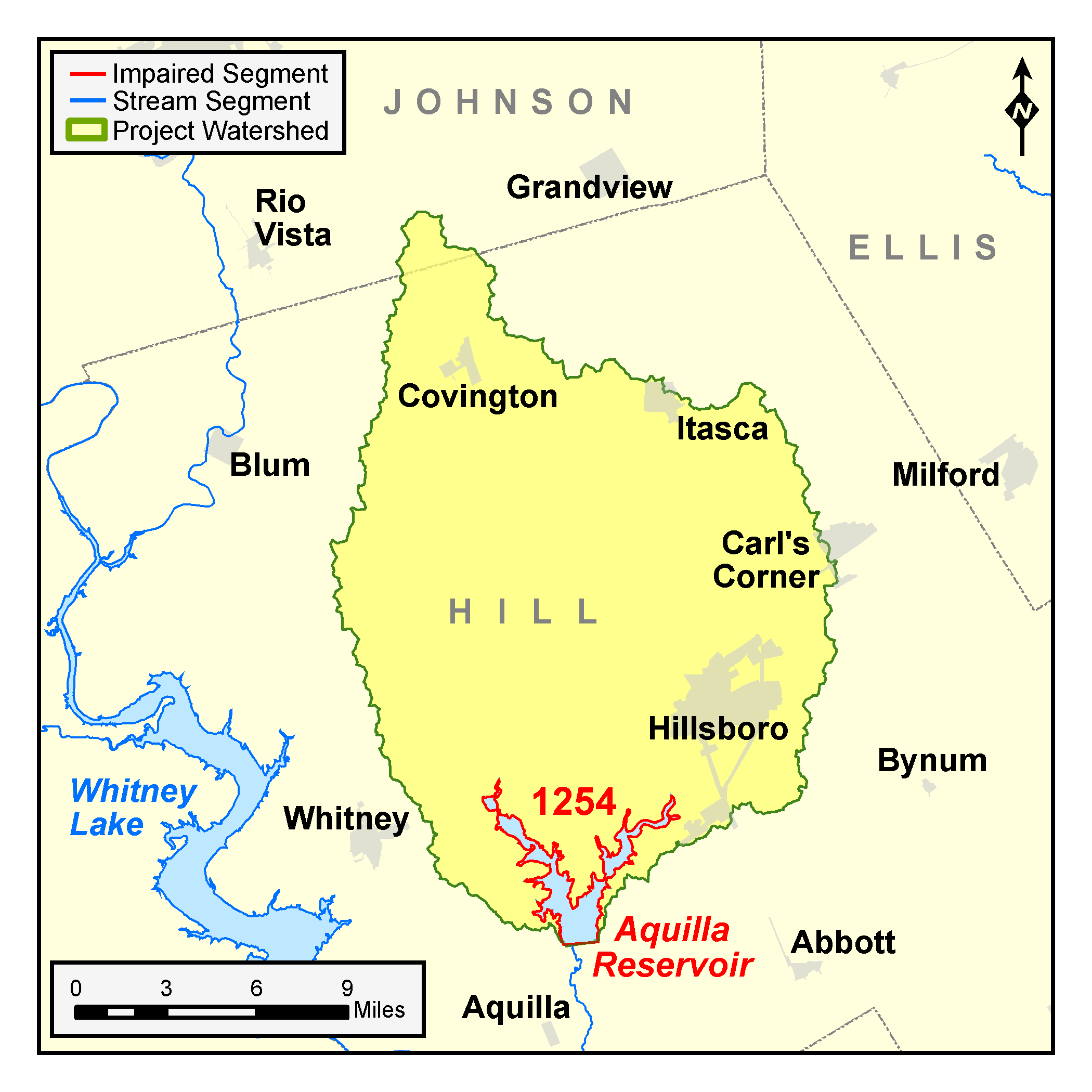Aquilla Reservoir: Drinking Water Sources

watershed of Aquilla Reservoir
County: Hill
Parameter: Atrazine
Basin: Brazos River
Segment: 1254
On this page:
- Background and Goal
- Watershed Description
- Status
- Public Participation
- Approved I-Plan
- Adopted TMDL
- Contact Us
Background and Goal
Aquilla Reservoir is a 3,280-acre lake located in Hill County. It was constructed in 1983 for use as flood control, recreation, and as a supply for drinking water treatment facilities. Testing of treated drinking water at a regional treatment facility found high levels of the herbicide atrazine, which pointed to contamination in the lake.
Agricultural sources were the primary contributors to pollution in the reservoir. The goal of the project was to reduce atrazine concentrations in the reservoir to safe levels.
Watershed Description
Aquilla Reservoir is a 3,280-acre reservoir on Aquilla and Hackberry Creeks in the Brazos River Basin, southwest of Hillsboro. The reservoir was constructed in 1983 and is owned by the U.S. Army Corps of Engineers. The reservoir's watershed is 255 square miles.
Aquilla Reservoir is an important resource to nearby communities. In 2000, it was the source of drinking water to about 8,000 people—including the communities of Hillsboro (population: 7,072), Milford (population: 711), and Bynum (population: 192), along with several water supply companies (Chatt, Files Valley, Hill County, Parker, Branden-Irene). The Corps of Engineers operates three parks by the lake — Dairy Hill Ramp (12,700 visitors annually), Old School Ramp (14,300 visitors annually), and Outlet Area (6,900 visitors annually).
Status
Atrazine concentrations in Aquilla Reservoir have been reduced to safe levels. Water from the reservoir is sampled at regular intervals to ensure that atrazine concentrations remain within an acceptable range. Routine tests of treated drinking water also continue and indicate that atrazine is below the criteria used determine its safety for human consumption. For more information about how the goal was achieved, read:
Public Participation
In all its projects, TCEQ gathers opinions and information from people who represent government, permitted facilities, agriculture, business, environmental groups, and community and private interests in the watershed. Stakeholder participation is vital to the success of TMDL projects. Two forums worked with TCEQ on the Aquilla Reservoir TMDL and I-Plan.
The Surface Water Protection Committee included representatives from the Texas State Soil and Water Conservation Board, the Texas Department of Agriculture, Texas A&M University, Novartis, USDA-Natural Resources Conservation Service, USDA-Agricultural Research Service, the Texas Farm Bureau, the Brazos River Authority, and municipal representatives.
A second stakeholder group included representatives of affected agricultural operations, water supply companies, and cities.
Approved I-Plan
Community stakeholders worked together to create the I-Plan. The Commission approved the stakeholders' plan on Jan. 18, 2002.
Adopted TMDL
The commission adopted this TMDL on March 23, 2001; it adopted revisions to the TMDL on June 14, 2002. The EPA approved the TMDL on Oct. 30, 2002, at which time it became part of the state's Water Quality Management Plan.
-
One TMDL for Atrazine in Aquilla Reservoir
Segment 1254 - Response to Public Comment on the Aquilla Reservoir TMDL
Contact Us
Please e-mail tmdl@tceq.texas.gov and mention Aquilla Reservoir in the subject line. Or call us at 512-239-6682.





 Back to top
Back to top